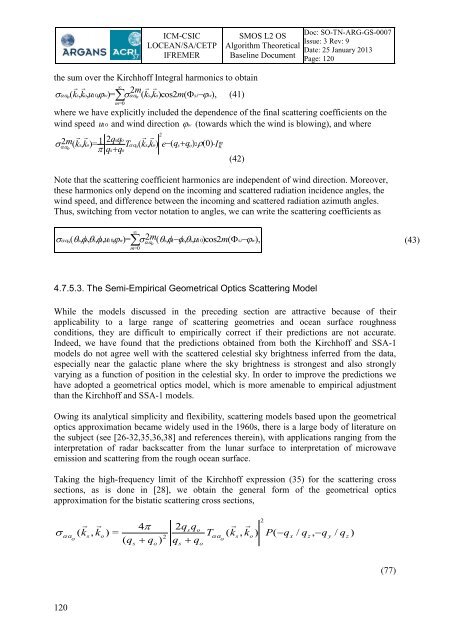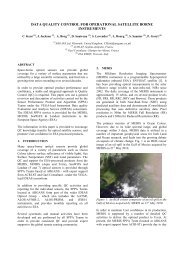SMOS L2 OS ATBD - ARGANS
SMOS L2 OS ATBD - ARGANS
SMOS L2 OS ATBD - ARGANS
Create successful ePaper yourself
Turn your PDF publications into a flip-book with our unique Google optimized e-Paper software.
120<br />
ICM-CSIC<br />
LOCEAN/SA/CETP<br />
IFREMER<br />
the sum over the Kirchhoff Integral harmonics to obtain<br />
<br />
( , , , ) =<br />
2m<br />
<br />
ks ko<br />
u10w<br />
<br />
( ks,<br />
ko)<br />
cos2m(<br />
siw),<br />
<br />
<br />
(41)<br />
o<br />
<br />
m=<br />
0<br />
o<br />
<strong>SM<strong>OS</strong></strong> <strong>L2</strong> <strong>OS</strong><br />
Algorithm Theoretical<br />
Baseline Document<br />
Doc: SO-TN-ARG-GS-0007<br />
Issue: 3 Rev: 9<br />
Date: 25 January 2013<br />
Page: 120<br />
where we have explicitly included the dependence of the final scattering coefficients on the<br />
wind speed u 10 and wind direction w (towards which the wind is blowing), and where<br />
<br />
m 2qsq<br />
2<br />
o<br />
2 ks<br />
k 1 o T s o<br />
m<br />
( , ) =<br />
<br />
o<br />
o(<br />
k , k ) e(<br />
qsqo)<br />
2(0)<br />
IK<br />
qsqo<br />
(42)<br />
Note that the scattering coefficient harmonics are independent of wind direction. Moreover,<br />
these harmonics only depend on the incoming and scattered radiation incidence angles, the<br />
wind speed, and difference between the incoming and scattered radiation azimuth angles.<br />
Thus, switching from vector notation to angles, we can write the scattering coefficients as<br />
o( <br />
10 <br />
o<br />
m=<br />
0<br />
<br />
o,<br />
o,<br />
s,<br />
s,<br />
u10, w)<br />
= 2m(<br />
o,<br />
s<br />
o,<br />
s,<br />
u ) cos2m(<br />
si<br />
w),<br />
4.7.5.3. The Semi-Empirical Geometrical Optics Scattering Model<br />
While the models discussed in the preceding section are attractive because of their<br />
applicability to a large range of scattering geometries and ocean surface roughness<br />
conditions, they are difficult to empirically correct if their predictions are not accurate.<br />
Indeed, we have found that the predictions obtained from both the Kirchhoff and SSA-1<br />
models do not agree well with the scattered celestial sky brightness inferred from the data,<br />
especially near the galactic plane where the sky brightness is strongest and also strongly<br />
varying as a function of position in the celestial sky. In order to improve the predictions we<br />
have adopted a geometrical optics model, which is more amenable to empirical adjustment<br />
than the Kirchhoff and SSA-1 models.<br />
Owing its analytical simplicity and flexibility, scattering models based upon the geometrical<br />
optics approximation became widely used in the 1960s, there is a large body of literature on<br />
the subject (see [26-32,35,36,38] and references therein), with applications ranging from the<br />
interpretation of radar backscatter from the lunar surface to interpretation of microwave<br />
emission and scattering from the rough ocean surface.<br />
Taking the high-frequency limit of the Kirchhoff expression (35) for the scattering cross<br />
sections, as is done in [28], we obtain the general form of the geometrical optics<br />
approximation for the bistatic scattering cross sections,<br />
<br />
<br />
o<br />
2<br />
4<br />
2qsq<br />
<br />
o<br />
( ks , ko<br />
) =<br />
T ( , ) ( / ,<br />
2<br />
ks<br />
ko<br />
P qx<br />
qz<br />
q<br />
( q q ) q q o<br />
s<br />
o<br />
s<br />
o<br />
y<br />
/ q<br />
z<br />
)<br />
(77)<br />
(43)



